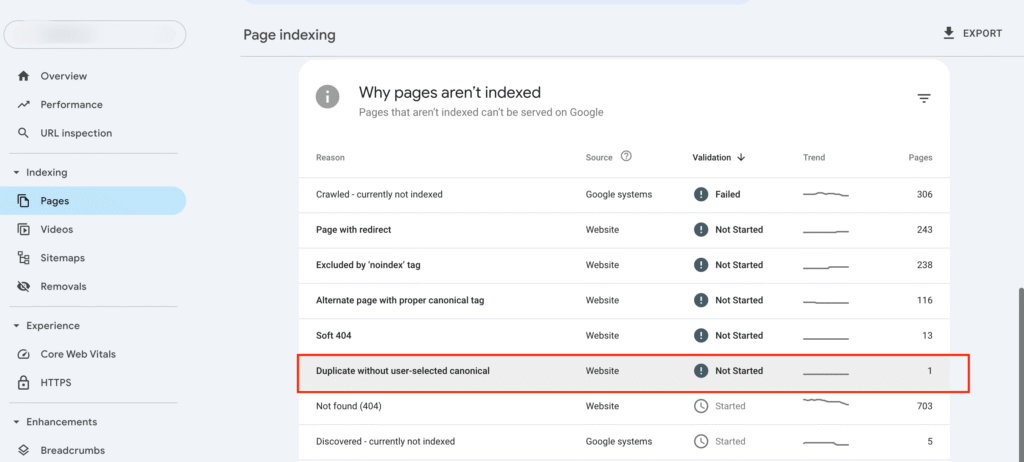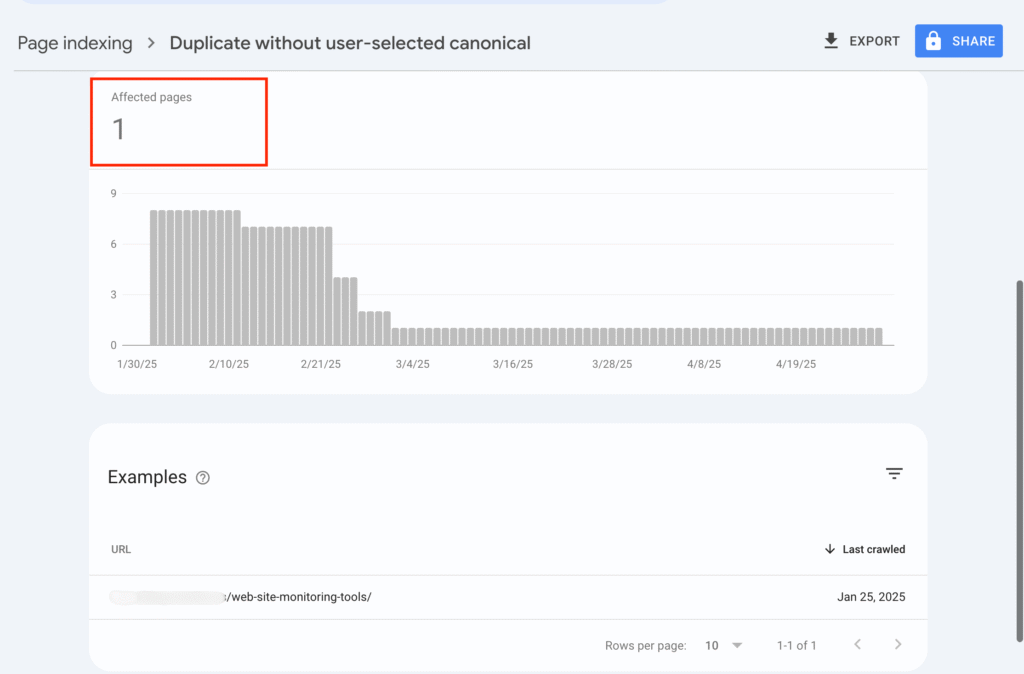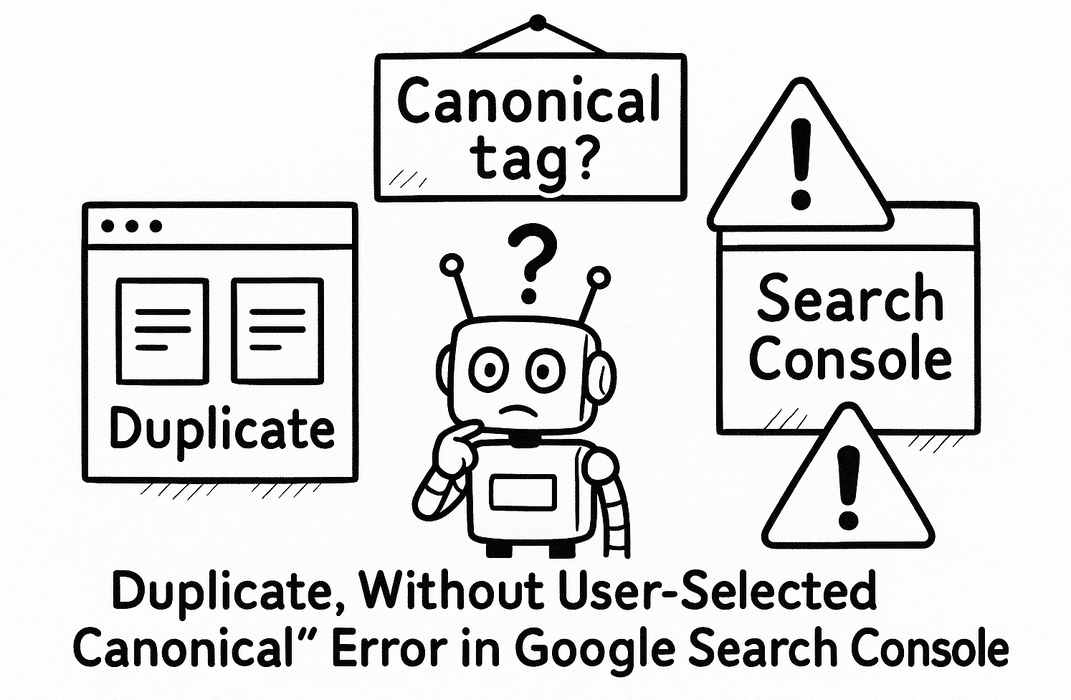Latest update: April 30, 2025
Google flags “Duplicate without user-selected canonical” when it finds similar content but can’t tell which page is the original, often because canonical tags or redirects are missing.
Fix it by adding canonical tags or setting up 301 redirects to point to the preferred page.c
What Does “Duplicate, Without User-Selected Canonical” Mean
The “Duplicate, Without User-Selected Canonical” error is a status you can see in GSC under the “Pages” report.
This status means that Googlebot has detected duplicate pages on your site, but you haven’t indicated which version should be treated as the primary URL.
As a result, Google independently selects the main URL based on its algorithms, which may not always match your preference.
This error can make indexing less efficient and reduce your control over what appears in search results.
Causes for “Duplicate, Without User-Selected Canonical” Error
What are the typical causes you should be aware of?
Different URLs Serving Matching Content
This error arises when different URLs present identical or near-identical materials.
Googlebot may treat pages as duplicates due to several factors:
- Alternate URL structures created by tracking parameters;
- Incorrect redirection for HTTP and HTTPS versions;
- URLs that include and exclude a trailing slash, etc.
No Canonical Tag
A canonical component is an HTML tag linking to the preferred destination. If you don’t have canonical tag, crawling bots won’t be able to decide which pages have higher priority.
Google makes the choice on its own without this directive. Its absence can cause the following problems:
- Uncontrolled listing and wasted crawl budget;
- Loss of authority;
- Disorder in ranking positions.
Canonicalization
Mistakes in implementing canonicalization could lead to duplication errors as well.
For instance, self-referencing canonical markers can mislead Google, and it won’t merge them accurately.
Also, Google can disregard this tag if there are multiple instances of it on a single page. Plus, these tags become useless when they point to non-indexable URLs.
Website Structure Issues
The website structure and internal linking have a huge impact on Googlebot when it picks the primary version of a page. It evaluates the backlinks to figure out which variant of your page gains the most references.
So, poor linking practices may lead to this error. These include
- Inconsistent internal links;
- Duplicate navigation paths;
- Breadcrumb differences, etc.
Repurposed Content
Content redistribution can lead to a “Duplicate, Without User-Selected Canonical” error too. This issue mostly arises when third-party websites republish your materials without properly crediting the original source.
You might notice a decline in search visibility and a lack of clarity about who owns the piece.
Step-by-Step Guide”Duplicate, Without User-Selected Canonical” Error
Googlebot scans similar pages on your site and arranges them to avoid cluttering. The “Duplicate, Without User-Selected Canonical” error interrupts this sequence. So, there’s a bigger possibility that the wrong version of your page will appear in the results.
You know where to spot this error in GSC. Now, complete the steps we’ve gathered to manage the problem.
Step 1: Locate the Error
First, track down the resources connected to the “Duplicate, Without User-Selected Canonical” error.
Visit the Google Search Console and sign in to your profile. Select the property you’d like to analyze.
Open the left-side menu and navigate to “Indexing”. Find the “Pages” report and scroll down to view the compilation of indexing errors in your system.

Look for the status “Duplicate without user-selected canonical” and click on it. You’ll see a chart illustrating the number of affected pages and the Examples section with every link directing to them.

Export this list to inspect each page with more precision.
Step 2: Utilize Canonical Tags
First, decide which edition of each page you wish to focus on and then apply a canonical tag.
As we’ve stated above, this tag is an HTML component. It informs browsers of pages for processing and positioning. Place the script shown in the screenshot into the <head> section of all redundant pages.
A canonical tag ensures that search engines understand which page holds the authoritative content. It consolidates ranking signals. So, different versions won’t compete against each other.
Step 3: Set Up Redirects
301 redirects may be a better solution if identical pages are not that valuable. You can also use them if you don’t want your visitors to access these resources.
This type of redirect permanently forwards traffic from duplicate pages to the URL of your choice. We suggest applying this strategy to manage URL inconsistencies provoked by
- HTTP vs. HTTPS;
- Closing slashes;
- Request parameters.
Redirection will help you achieve better UX and prevent misunderstandings.
Step 4: Check Internal Linking Organization
Another measure you can take to handle the “Duplicate, Without User-Selected Canonical” error is to adjust your internal linking.
Check if the internal links on your site route to the planned URL rather than showing replicated variations. These links simplify crawler direction and the consolidation of page authority.
When your site consistently directs to the correct version, it strengthens Google’s understanding of the pages it should rank.
Step 5: Refresh your XML Sitemap
Next, you have to rework your XML sitemap and robots.txt file to prevent any future conflicts. Your sitemap should only include canonical URLs to let browsers crawl and index the right resources. Resubmit the reworked sitemap to the Google Search Console.

Step 6: Validate Modifications
After implementing all the modifications, you need to supervise them to see if everything works correctly. Visit your GSC profile and view the problematic page. Pick the “Validate Fix” option to proceed.
Then, you can use the URL Inspection tool to reassess all points and verify that Google recognizes the tags you added. Consider requesting indexing to accelerate the process.

Key Takeaways on Fixing Duplicate, Without User-Selected Canonical
- “Duplicate, Without User-Selected Canonical” error affects the quality of indexing procedures, and Google shows the wrong version of your page.
- The main causes for this error are site structure issues, no canonical tag, or unstable canonicalization.
- To resolve this problem:
- Locate the problem.
- Implement canonical tags.
- Use appropriate redirects.
- Index several pages.
- Optimize your internal linking.
- Update the sitemap and request indexing
If you encounter other errors, refer to our Google Search Console guidelines to resolve them.


